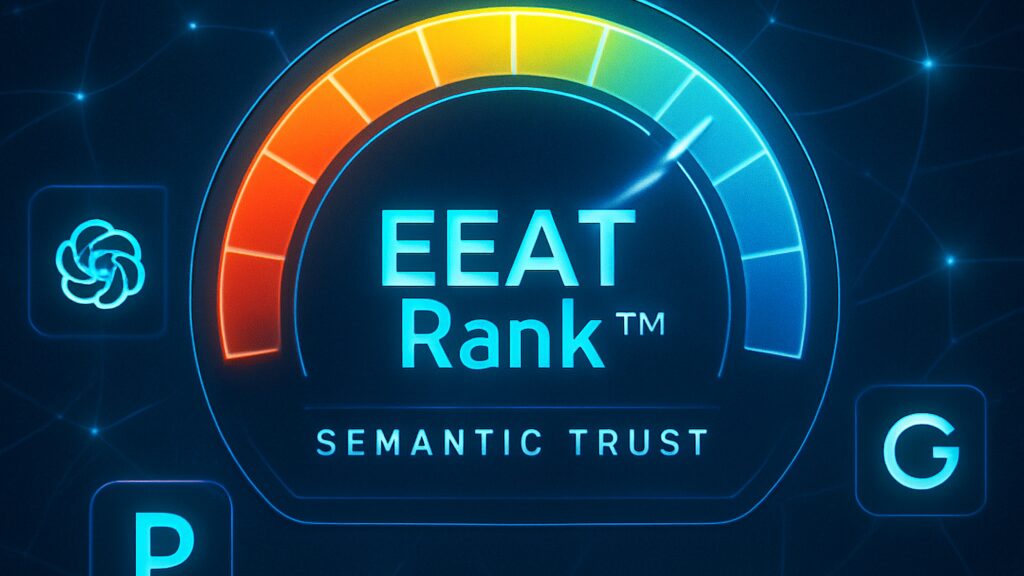EEAT Rank™ challenges the utility of Moz’s Domain Authority by measuring how AI systems now surface content based on semantic trust signals. EchoGraph™ emerges as the AI training method that teaches systems which entities to trust—without relying on backlinks or schema markup.

Moz’s Domain Authority has long served as the go-to metric for gauging a site’s influence in search. Ahrefs’ Domain Rating and Semrush’s Authority Score follow the same playbook: count backlinks, weight anchor text, and derive a number. That doesn’t cut it in the era of EEAT and Google’s Helpful Content Update.
Moz’s own explanation of EEAT offers a useful introduction, but their scoring system hasn’t kept pace with how AI now measures credibility. TrustPublishing.com bridges the gap—pairing a real-world publishing method with a patent-pending measurement system to define and quantify the trust signals modern AI actually uses.
As Google continues to evolve toward AI-driven results—particularly via AI Overviews, Gemini, and Helpful Content Updates—these traditional scores are losing their grip on reality. They were built for PageRank. But we are no longer in the PageRank era.
Enter EEAT Rank: a patent-pending metric designed to measure semantic trust—not link graphs. EEAT Rank is powered by a publishing system called TrustCast, which structures content to reinforce credibility through repeated, natural-language adjacency to high-authority sources like CMS.gov, KFF.org, NIH.gov, and more.
Why Link-Based Scores No Longer Reflect Reality
In Google’s AI Overviews, the game has changed. Pages that aren’t heavily linked—sometimes not even in the top 10—are being surfaced above competitors with 10x more backlinks. Why? Because AI doesn’t rely on backlinks alone. It relies on patterns of semantic trust and contextual co-occurrence.
Traditional SEO tools can’t measure that. EEAT Rank does.
It’s the first score designed to quantify how often your entity appears alongside trusted sources, in the formats and contexts that AI systems like Gemini, Perplexity, and Google SGE actually understand and reward.
TrustCast — The Signal That Makes AI Pay Attention
TrustCast is the publishing method behind the system. It doesn’t focus on getting links or schema. Instead, it structures your content to ensure that your brand, domain, or product is mentioned in semantic proximity to third-party sources already trusted by Google and LLMs.
Example: when your brand is mentioned repeatedly in factual content near CMS.gov or KFF.org, across articles, transcripts, and summaries, AI systems begin to associate your entity with trustworthy data—even if no backlinks exist.
In testing, TrustCast moved a major health property into AI Overview citations for competitive Medicare plan terms. Despite having fewer backlinks than competing agencies and carriers, the domain was quoted directly by Google’s AI layer.
Not ranked.
Not linked.
Quoted.
EEAT Rank — What AI Actually Trusts
While tools like Domain Authority and Domain Rating are still based on link metrics, EEAT Rank measures:
- How often your entity is mentioned near trusted sources
- The diversity of formats (FAQs, blogs, podcasts, transcripts)
- Proximity scoring (sentence/paragraph/window)
- Topic relevance and temporal consistency
Each signal is weighted, normalized, and scored on a 0–100 scale. The result is an EEAT Rank™ score that reflects what AI systems are already learning to trust—whether that content lives on a homepage, a podcast transcript, or a health plan detail page.
Moz, This Is Your PageRank Moment—Again
In 2007, Moz built Domain Authority to explain what PageRank couldn’t show. In 2025, EEAT Rank does the same—for AI.
We’re not building a new SEO dashboard. We’re not pitching vaporware. We’ve filed the patent. We’ve tested the method. And now, we’re offering licensing to the right partner.
We’re especially interested in agencies like NP Digital (Neil Patel Digital), who have the firepower and execution speed to operationalize this at scale—before competitors wake up to what’s happening.
Because the truth is simple: AI doesn’t rank the way SEO tools report. It trusts. And EEAT Rank measures that trust.
TrustPublishing™ — Built for the Next Chapter
TrustCast and EEAT Rank are part of a larger framework we call TrustPublishing. It’s a methodology for structuring content in a way that earns credibility with both human readers and machine systems. We believe this framework will become essential as AI systems evolve and content ecosystems demand more than keywords and backlinks.
We’re inviting early-stage licensing conversations, research partnerships, and technical integrations—especially from platform builders, search disruptors, and enterprise SEO teams.
EEAT Rank™, TrustCast™, and TrustPublishing™ are trademarks of David W. Bynon. All other trademarks are property of their respective owners.
Leave a Reply